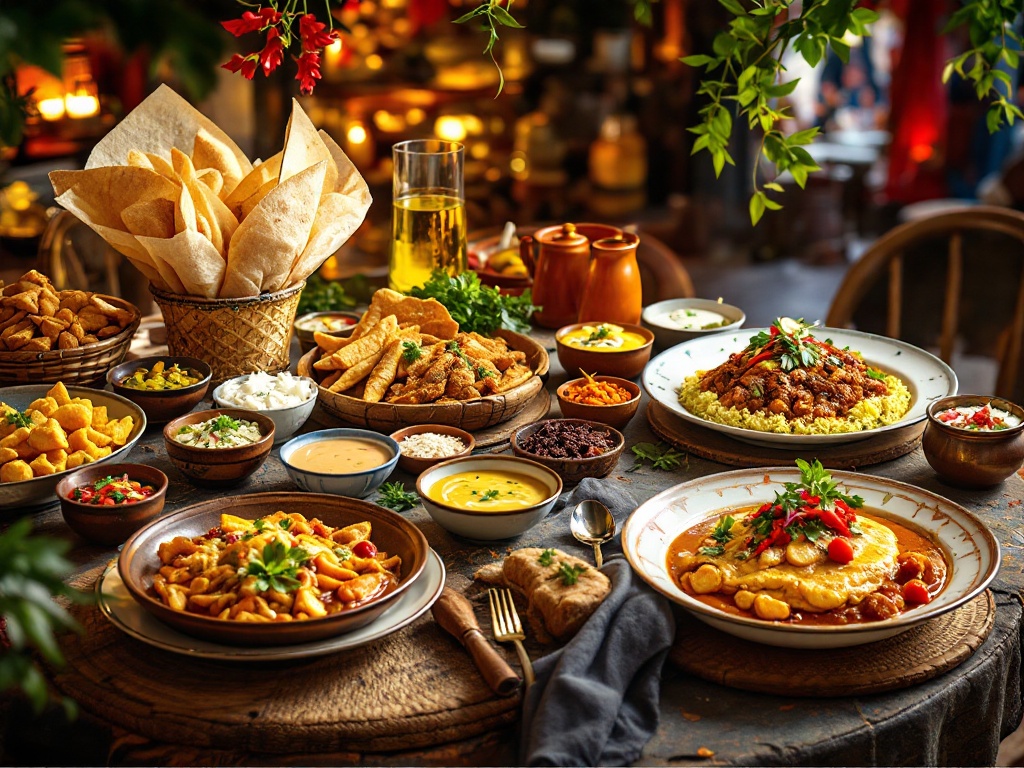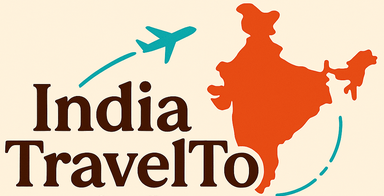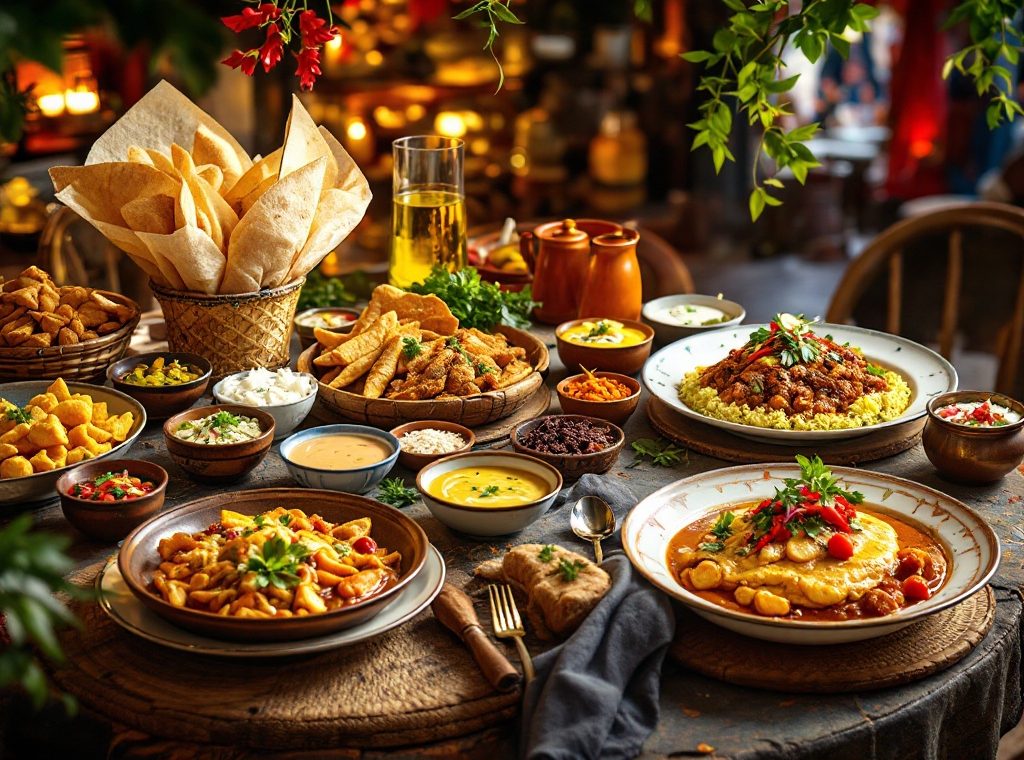Street Food to Fine Dining: Culinary Adventures on Your Two-Week Trip to India
Embark on an unforgettable culinary adventure through India, a land of vibrant spices and diverse flavors. From the fiery vindaloo of Goa to the aromatic Rogan Josh of Kashmir, explore a tapestry of regional specialties, including creamy curries, lentil stews, and flavorful vegetarian dishes. Discover the lively street food scene, savoring must-try treats like chaat, vada pav, and samosas while learning essential food safety tips. Delve into fine dining experiences with Mughlai and Rajasthani cuisine, or indulge in the unique traditions of Jain vegetarian cooking. Plan your two-week culinary journey through Delhi, Mumbai, Goa, Rajasthan, and Amritsar, and enhance your experience with cooking classes, food tours, and spice farm visits. Don’t forget to savor India’s delightful desserts, from the classic gulab jamun to regional specialties. Start your culinary exploration now!
Important information

- Indian cuisine is incredibly diverse, varying by region. From the spicy vindaloo of Goa to the creamy Rogan Josh of Kashmir, each area offers unique flavors and cooking styles.
- Street food is an essential part of Indian culinary culture. Enjoy chaat, vada pav, and pav bhaji, but prioritize busy stalls and consider food safety practices.
- Explore fine dining with Mughlai cuisine (rich, creamy curries) and Rajasthani cuisine (bold spices). India also offers diverse vegetarian options, including Jain cuisine.
- Plan your culinary journey to include cities like Delhi (chaat, parathas), Mumbai (vada pav, pav bhaji), Goa (seafood), Rajasthan (thalis), and Amritsar (Punjabi cuisine).
- Immerse yourself in Indian food culture with cooking classes, food walking tours, and spice farm visits.
Introduction to Culinary Adventures in India
India’s vibrant food scene reflects its rich history and culture, bursting with diverse flavors. A masterful use of spices creates a complex tapestry of tastes, ranging from delicate to fiery. The result is a truly delicious culinary adventure.
The Diversity of Indian Cuisine
Indian cuisine offers a diverse culinary experience, shaped by regional ingredients and unique cooking methods. Southern India is known for its spicy curries, while Northern India features creamy dishes. Explore the fiery vindaloo of Goa, the aromatic Rogan Josh of Kashmir, or the Thali platters of Rajasthan. With its incredible variety, Indian food caters to every taste.
Exploring Regional Flavors
India’s culinary landscape offers a diverse tapestry of flavors, varying significantly by region.
Kashmir
Known for its fragrant Rogan Josh, Kashmir provides a unique lamb curry experience.
Goa
Coastal Goa offers a distinct culinary adventure, with seafood infused with Portuguese influences.
Punjab
Punjab’s cuisine, rich and decadent, features favorites like the buttery Makhani Dal.
Rajasthan
Rajasthan is celebrated for its hearty lentil stews.
Tamil Nadu
Tamil Nadu tantalizes taste buds with flavorful vegetarian dishes, including the ever-popular dosa.
Street Food Culture in India
Indian street food is essential to the country’s culinary tapestry, a vibrant mosaic of regional flavors. These authentic tastes often reveal more about local traditions than upscale restaurants. Street food stalls offer a lively, immersive experience, reflecting daily life. Popular choices include chaat, vada pav, and pav bhaji, but each region boasts its own unique specialties, offering a true taste of India.
Understanding Indian Street Food
Indian street food offers a vibrant cultural experience with an explosion of flavors and textures. These unique dishes, often made with specialized techniques, showcase regional specialties not found in upscale restaurants. It’s a casual way to immerse yourself in local traditions.
Savoring Street Food Safely
Food safety is key when enjoying street food. Choose busy stalls where high turnover ensures freshness. Observe the vendor’s hygiene and food handling. Prioritize fried or grilled items, and opt for bottled or hot beverages.
- Choose busy stalls, where high turnover ensures freshness.
- Observe the vendor’s hygiene and food handling.
- Prioritize fried or grilled items.
- Opt for bottled or hot beverages.
Tips for a Safe Culinary Adventure
Hot chai and freshly fried samosas are generally safe bets. Frequently use hand sanitizer. Consider trying popular local favorites, which are usually safe. Carrying stomach medication is a wise precaution.
- Hot chai and freshly fried samosas are generally safe bets.
- Frequently use hand sanitizer.
- Consider trying popular local favorites.
- Carry stomach medication as a precaution.
To experience the full spectrum of Indian cuisine, incorporate both street food and fine dining into your travel plans.
Must-Try Street Foods
Aloo Chaat explodes with flavor, mixing crispy potatoes, tangy chutneys, and fragrant spices. Samosas, whether fried or baked, offer a savory pastry filled with spiced potatoes and peas. For a truly unique sensation, try Pani Puri: imagine crunchy, hollow spheres bursting with flavored water, tamarind chutney, and chickpeas.
A comforting cup of Masala Chai, a spiced tea, warms the soul. Paan, a betel leaf treat, provides a refreshing contrast. Then there’s Kachori, a spicy, deep-fried patty, and Lassi, a cool yogurt drink perfect for a hot day.
Don’t miss Vada Pav, a flavorful potato fritter in a soft bun. Also, try Pav Bhaji, a rich vegetable mash with buttered bread.
Beyond these favorites lies a vast culinary landscape. Explore regional specialties like Dosa in South India or the diverse Kachori variations of North India. Indian street food truly has something to tantalize every palate.
Ensuring Food Safety
Food walking tours prioritize your safety by selecting clean, popular stalls. High customer turnover ensures fresh food and minimizes health risks, allowing you to savor authentic street food without worry.
Fine Dining Experiences in India
Indian cuisine offers a stunning array of flavors and traditions. Exploring Mughlai and Rajasthani food reveals a captivating culinary history. Born from the Mughal Empire, Mughlai cuisine tantalizes with fragrant biryanis, succulent kebabs, and rich gravies. Rajasthani cuisine, in contrast, whispers tales of the desert. Dishes like dal baati churma and fiery laal maas showcase the region’s distinctive ingredients and cooking styles. India also boasts a vibrant vegetarian landscape, featuring lentil curries, vegetable stews, and aromatic rice dishes. Jain cuisine, with its strict adherence to vegetarianism and exclusion of root vegetables, further expands the country’s culinary diversity. With such a rich tapestry of flavors, India truly satisfies every palate.
Exploring Mughlai and Rajasthani Cuisine
Mughlai cuisine, a hallmark of the Mughal Empire, is renowned for its rich, creamy curries often featuring nuts and dried fruits. Dishes like biryani and korma exemplify this decadent style. Mughlai cuisine frequently graces the menus of upscale restaurants across India, particularly in cities like Delhi and Agra, offering diners a luxurious culinary experience.
Rajasthani cuisine, originating from the desert state of Rajasthan, uses bolder spices in dishes such as Laal Maas (a meat curry) and Dal Baati Churma. Rajasthani cuisine is also a complex and flavorful cuisine found in upscale restaurants throughout Rajasthan, offering a unique culinary experience.
Vegetarian Delights and Jain Cuisine
Jain cuisine, a shining example of India’s vegetarian food paradise, follows unique culinary traditions. It avoids root vegetables like onions, garlic, potatoes, and carrots, as well as meat, eggs, and honey. These restrictions, however, enhance the cuisine’s distinctiveness by highlighting other ingredients. Lentils, grains, and dairy take center stage, complemented by diverse vegetables and spices like ginger, turmeric, and cumin. The result is a collection of flavorful and remarkably unique dishes.
Culinary Stops on Your Two-Week Trip
India’s culinary landscape offers a diverse range of regional specialties. Delhi’s street food scene is a must-visit, with iconic chaat and parathas. Mumbai is famous for vada pav and pav bhaji, while Goan cuisine features fresh seafood and aromatic spices. Rajasthan’s heritage hotels offer traditional thalis, and Amritsar in Punjab is a hub for rich Punjabi cuisine.
Delhi
Explore the vibrant street food scene, savoring iconic chaat and delicious parathas.
Mumbai
Indulge in the city’s famous vada pav and pav bhaji, must-try snacks for any visitor.
Goa
Experience a unique blend of fresh seafood and aromatic spices in Goan cuisine.
Rajasthan
Enjoy traditional thalis at stunning heritage hotels for a truly cultural experience.
Amritsar
Embark on a culinary adventure with rich Punjabi cuisine in Amritsar, Punjab.
Delhi: Chaat and Parathas
Delhi’s street food scene is renowned for its iconic dishes. Chaat, for instance, offers a savory explosion of crispy textures and tangy flavors. Another favorite is the paratha, a flavorful flatbread filled with anything from potatoes and cauliflower to paneer. These treats are a must-try for any food enthusiast.
- Chaat: experience a delightful mix of crispy textures and tangy flavors.
- Paratha: savor a flavorful flatbread with various fillings, from potatoes and cauliflower to paneer.
- Other must-try treats: explore the diverse world of Delhi’s street food and discover other culinary gems.
Mumbai: Vada Pav and Pav Bhaji
Vada Pav, a Mumbai street food staple, consists of a crispy potato fritter nestled in a soft bread roll—a simple yet satisfying snack. Pav Bhaji, another Mumbai favorite, offers a flavorful mashed vegetable curry with a spicy kick, served alongside buttery bread for a truly comforting experience.
Goa: Seafood and Spice
Goan cuisine, reflecting its coastal location, prominently features seafood. Dishes burst with vibrant flavors from spices like kokum, turmeric, and chilies. The Portuguese influence is evident in dishes such as vindaloo and recheado masala, showcasing a delicious fusion of cultures.
Rajasthan: Thali and Heritage Hotels
Experience the rich culinary heritage of Rajasthan with a traditional Thali. This vibrant platter is a feast for the senses, offering a mix of dal, vegetables, roti, rice, and sweet treats. You can find Thalis in restaurants and heritage hotels throughout Rajasthan. For a truly immersive experience, dine in a heritage hotel, often a converted palace or haveli. Imagine savoring this delicious meal within the opulent walls of a former royal residence. Some hotels even offer cooking demonstrations, unveiling the secrets of Rajasthani cuisine. Explore Rajasthan’s rich culture and savor a Thali for an unforgettable culinary adventure.
Punjab: Amritsar and Punjabi Cuisine
Amritsar, located in India’s Punjab region, is renowned for its flavorful Punjabi cuisine. Dishes often feature rich ingredients like ghee and butter, resulting in incredibly savory meals. Some popular examples include the creamy, tomato-based butter chicken, dal makhani (a slow-cooked lentil dish), and sarson da saag (a vibrant mustard greens dish typically served with makki di roti, a hearty cornbread). These staples offer a true taste of Punjab’s culinary heritage.
Experiential Culinary Activities
Experience the rich tapestry of Indian culinary culture through these immersive activities:
- Hands-on cooking class: Learn to prepare a delicious thali, exploring regional specialties and traditional techniques.
- Walking food tour: Explore vibrant markets and street food stalls, savoring an explosion of flavors.
- Spice farm visit: Witness the origin of Indian spices and learn about their incredible diversity.
Cooking Classes and Thali Preparation
Indian cooking classes often highlight the art of preparing a North Indian thali, a balanced and diverse platter of dishes. This traditional meal includes lentil dal, flavorful vegetable dishes, fluffy rice, and roti, the quintessential Indian flatbread. Chutney and raita, a refreshing yogurt-based dip, complete the experience.
Food Walking Tours and Local Markets
Experience the true essence of a city through its vibrant culinary scene with a food walking tour. Explore bustling markets and savor authentic street eats while immersing yourself in the local culture. Knowledgeable guides provide captivating insights into regional traditions, unique ingredients, and local cooking methods. With a focus on safe eating practices, tours carefully select reputable vendors, ensuring a delightful and worry-free experience. Discover hidden culinary gems in iconic locations such as Old Delhi’s vibrant Chandni Chowk or Mumbai’s flavorful Mohammed Ali Road. Embark on a food walking tour for an unforgettable cultural and culinary adventure.
Visiting Spice Farms
Embark on a sensory adventure at a spice farm, where vibrant colors, fragrant leaves, and aromatic spices await. You can witness the cultivation process firsthand, learning about both traditional methods and modern techniques. Many farms also offer the unique opportunity to purchase fresh, top-quality spices directly from the source.
Sweet Endings: Indian Desserts to Try
Indulge in timeless classics like gulab jamun, deep-fried milk balls bathed in a luscious syrup. Another popular delight is jalebi, a crispy, bright orange confection made from fermented batter. And for a truly delightful experience, savor the spongy sweetness of rasgulla, cheese balls soaked in syrup.Venture beyond the familiar and discover regional specialties like Mysore pak, a rich, fudge-like treat from Karnataka with a distinctive texture and taste. For a comforting dessert, try phirni, a creamy rice pudding enjoyed across many regions. Finally, Bengali sandesh, crafted from fresh cheese, offers a captivating array of flavors and shapes.
Traditional Favorites like Gulab Jamun
Gulab jamun is a beloved milk-solid dessert enjoyed across various regions, including India, Nepal, Pakistan, the Maldives, and Bangladesh. Its widespread appeal also reaches Myanmar, Mauritius, Fiji, and South Africa. The preparation involves gently deep-frying khoya, which is then soaked in a flavorful sugar syrup. This syrup is infused with aromatic spices like cardamom, rose water, kewra water, or saffron. The addition of rose water, in particular, gives gulab jamun its characteristic rosy hue and subtle floral essence.
Unique Regional Sweets
India’s diverse culinary heritage shines through its regional sweets. From Goa’s layered Bebinca to Karnataka’s rich Mysore Pak and Uttar Pradesh’s delicate Peda, these treats offer a delicious glimpse into the country’s varied flavors.














